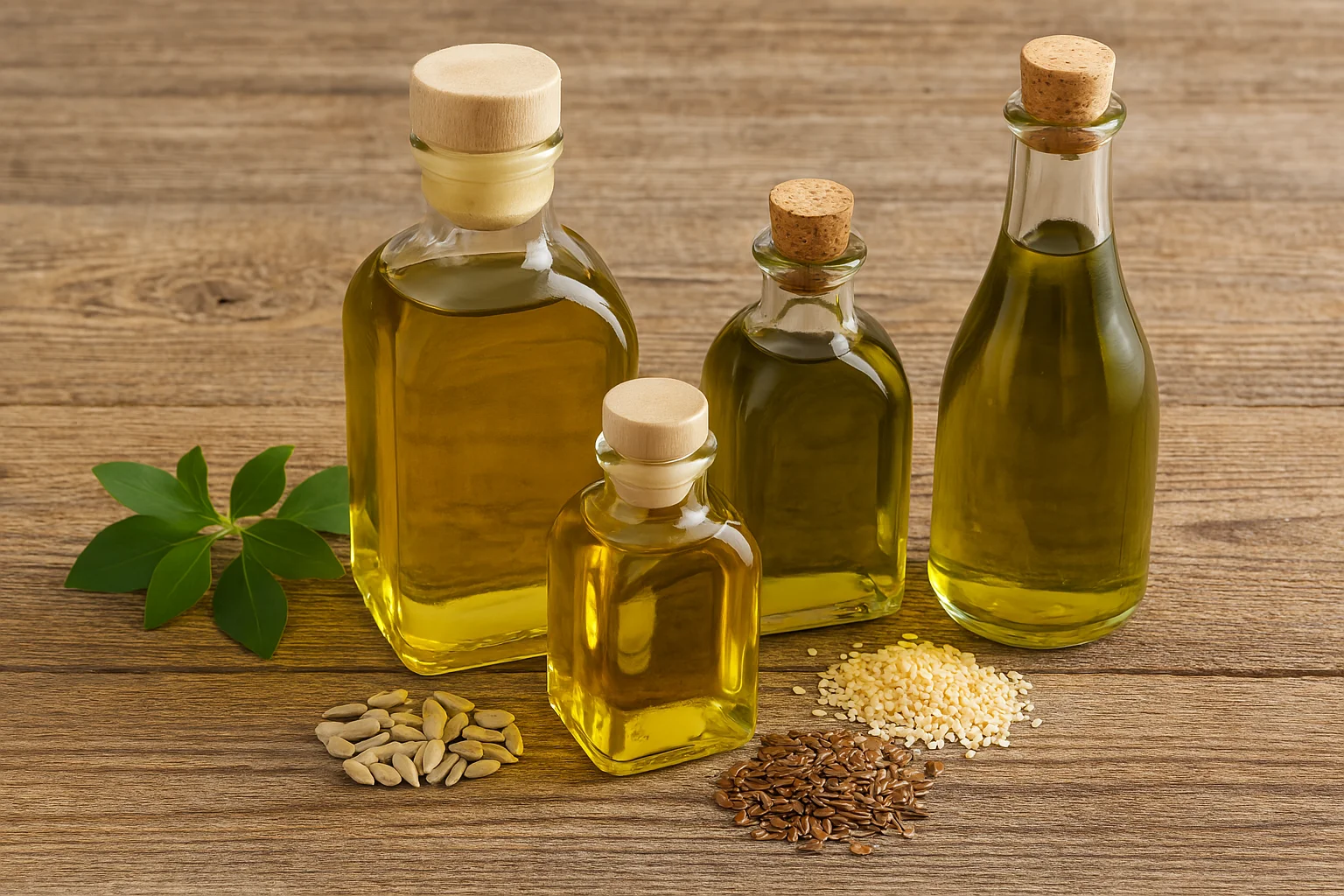The Benefits of Tallow Soap: Healthier Skin Every Day
March 29, 2025 | by iprittie@gmail.com
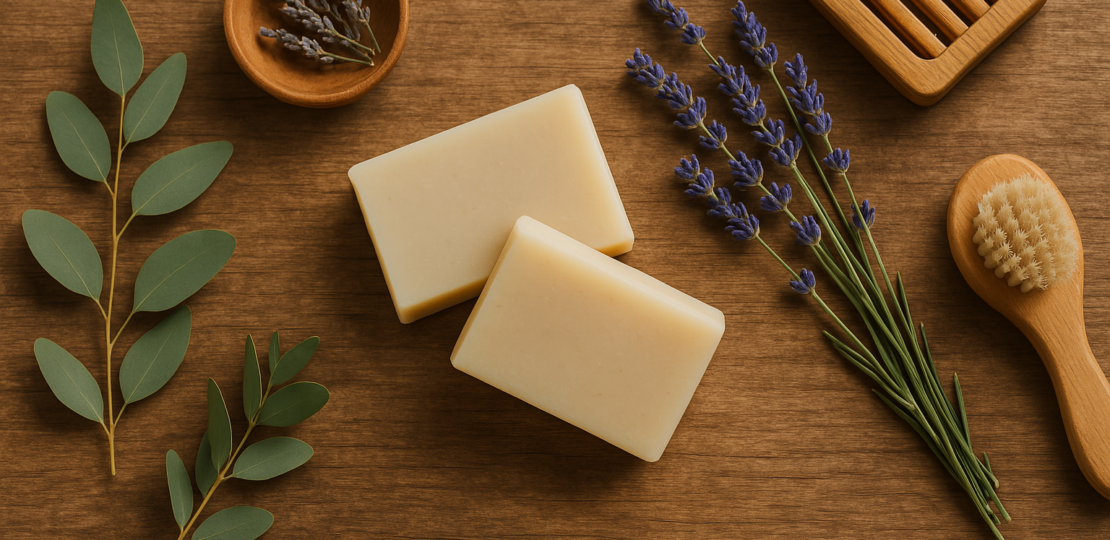
Time for healthier skin! Looking for a wonderful natural soap without harmful chemicals and dyes?
In the world of natural skincare, tallow soap is making a remarkable comeback. This traditional soap, made from rendered animal fat, offers a unique combination of cleansing and moisturizing properties that modern synthetic products often lack. Tallow soap is rich in vitamins A, D, E, and K along with essential minerals and antioxidants that help repair and soothe the skin, making it an excellent choice for those seeking natural skincare alternatives.
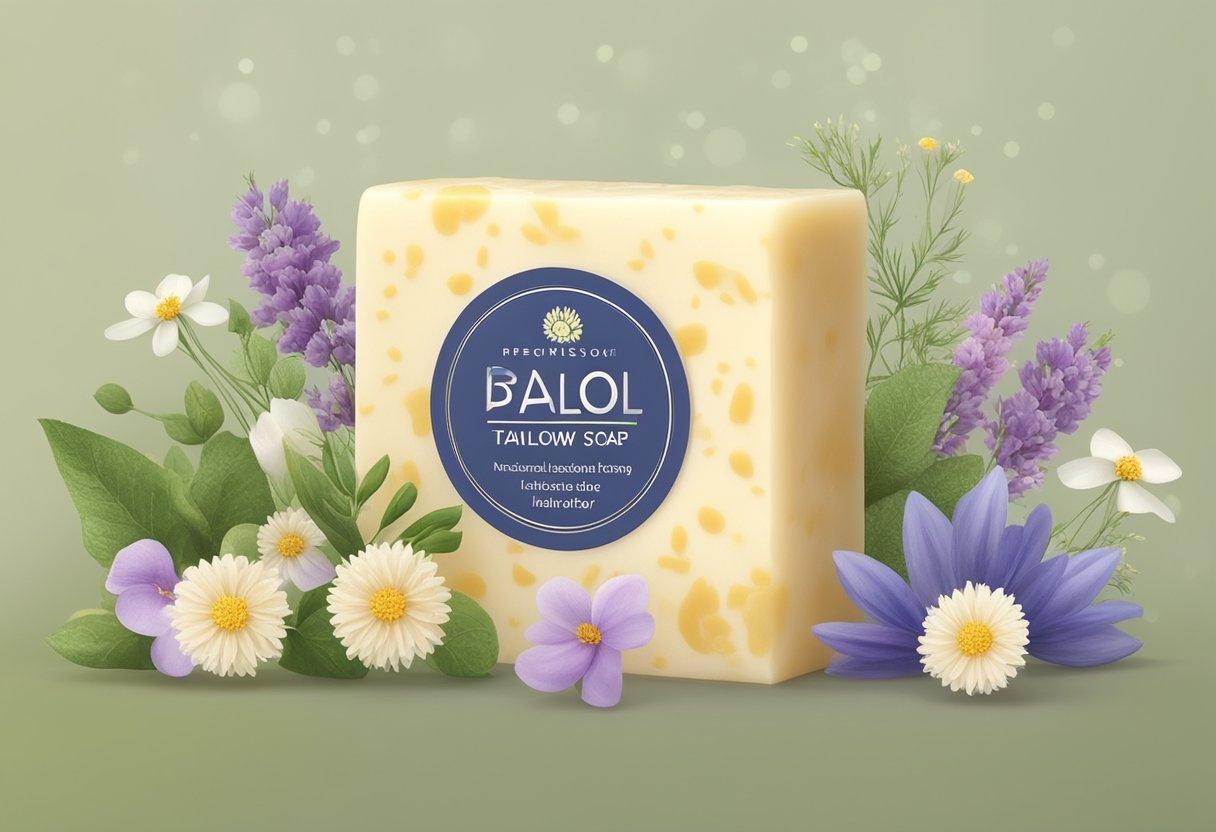
When applied to the skin, tallow soap immediately softens and hydrates, unlike many commercial soaps that can leave skin feeling tight and dry. The fatty acid composition of tallow closely resembles the natural oils in human skin, allowing it to effectively strengthen your skin’s protective barrier while gently cleansing away impurities.
For those with dry or sensitive skin conditions, tallow soap offers nourishment and repair without harsh chemicals or synthetic additives. The natural composition provides a balanced approach to skincare, effectively removing dirt and excess oil while maintaining the skin’s natural moisture balance.
Key Takeaways
- Tallow soap contains vitamins A, D, E, and K that nourish skin while cleansing.
- The fatty acid profile in tallow closely mimics human skin’s natural oils for superior moisturization.
- Natural tallow soap supports the skin’s protective barrier without stripping essential moisture.
Exploring Tallow as a Rich Skincare Ingredient
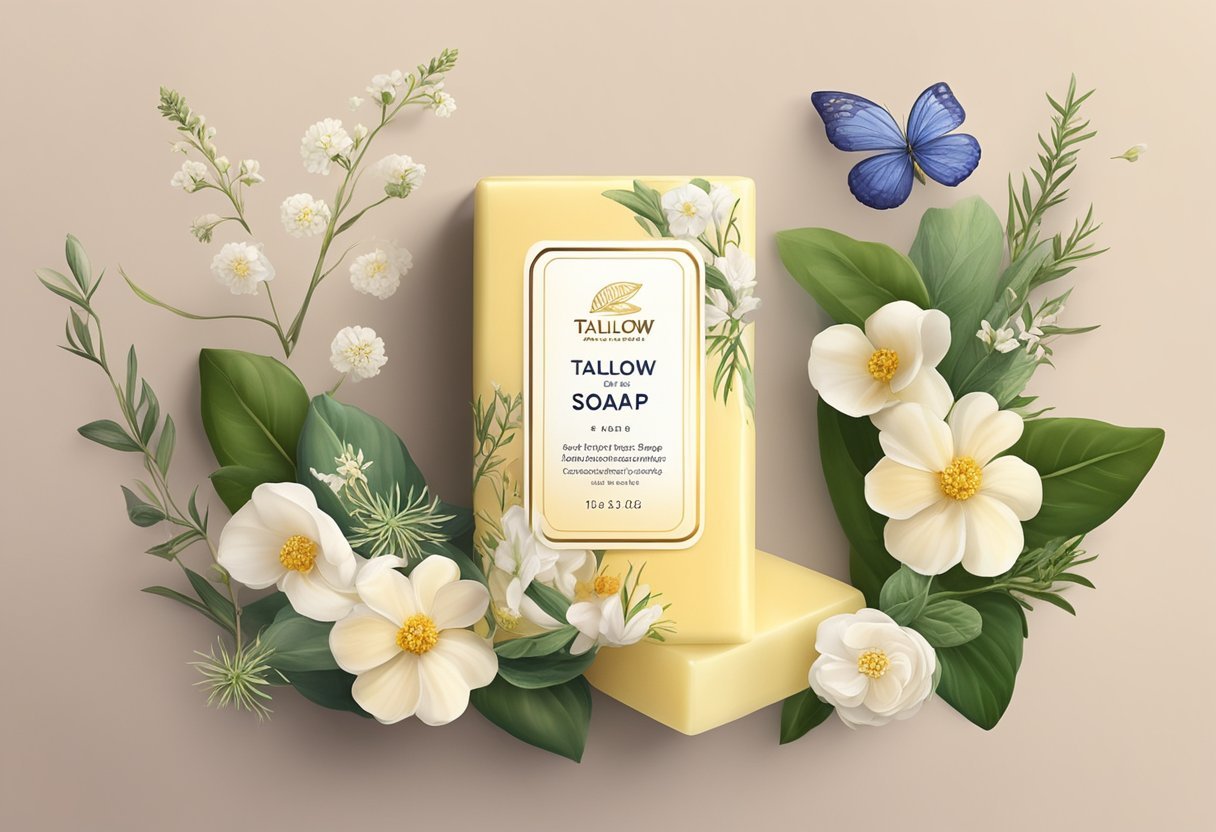
What makes it a great choice? Tallow offers exceptional benefits for skin health due to its unique molecular structure and nutrient profile. This natural substance contains vitamins and fatty acids that closely resemble those found in human skin.
What Is Tallow
Tallow is rendered animal fat, primarily from beef, that has been purified and processed for various uses. It consists mainly of triglycerides with a high concentration of saturated and monounsaturated fatty acids.
When processed properly, tallow becomes a smooth, firm substance with a mild scent and creamy texture. The molecular structure of tallow is remarkably similar to human sebum, making it highly compatible with our skin.
Beef tallow contains fat-soluble vitamins including A, D, E, and K, along with essential minerals that support skin health. These nutrients aren’t typically found in plant-based oils used in commercial skincare products.
The fatty acid profile of tallow includes palmitic, stearic, and oleic acids, which serve as powerful emollients for the skin.
Historical Use of Tallow in Skincare
Throughout history, many cultures utilized tallow as a primary ingredient in skincare preparations. Ancient civilizations recognized its effectiveness for protecting and healing the skin.
Indigenous peoples commonly used tallow mixed with herbs for treating wounds, preventing moisture loss, and protecting skin from harsh environmental conditions. The substance was a staple in traditional medicine cabinets.
During the 18th and 19th centuries, tallow was a common ingredient in soaps, salves, and balms. Households would render their own tallow and create multipurpose skincare products.
Before the advent of petroleum-based products and commercial cosmetics, tallow served as one of the most reliable and accessible skincare ingredients available to people across different social classes.
Benefits of Tallow for Nourishing Skin
Tallow provides exceptional moisturizing properties as it replenishes the skin’s natural oils and locks in moisture. This makes it particularly beneficial for dry, sensitive, or mature skin types.
The vitamin content in tallow supports skin healing and regeneration. Vitamin A helps with cell turnover, vitamin D promotes skin cell growth, vitamin E serves as an antioxidant, and vitamin K assists with healing.
Research suggests tallow-based soaps have higher antibacterial efficacy compared to purely alkaline soaps, especially when combined with herbal ingredients.
As an effective emollient, tallow softens and smooths the skin by filling in spaces between skin cells. This creates a protective barrier against environmental aggressors while allowing the skin to breathe naturally.
Unlike synthetic moisturizers, tallow doesn’t contain artificial preservatives or fragrances that might irritate sensitive skin or cause negative health effects. Its natural properties contribute to a luxurious lather and excellent cleansing experience.
The Importance of Moisturizing Properties in Soap
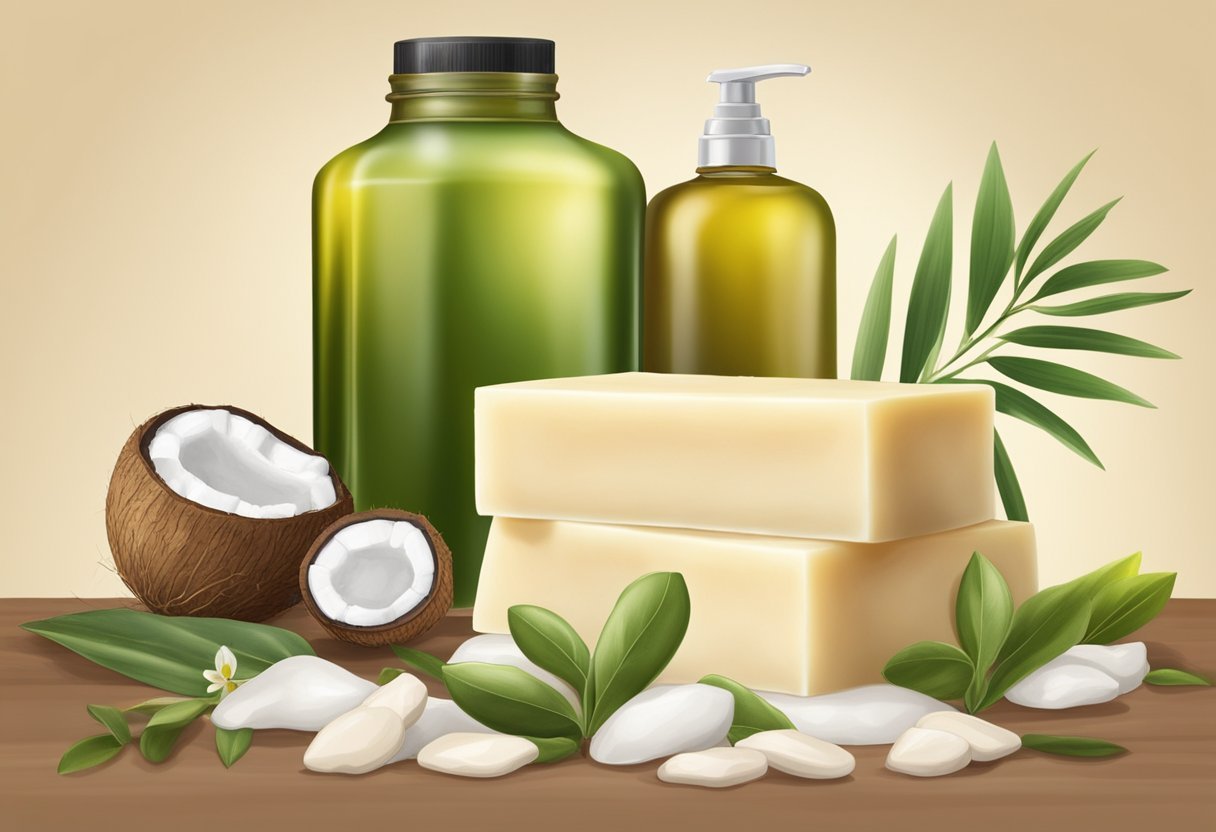
Effective soaps balance cleansing with moisturizing to maintain skin health and comfort. The fatty acid composition and additional ingredients in soap determine how it affects skin hydration after washing.
How Tallow Soap Hydrates the Skin
Tallow soap provides exceptional moisturizing benefits due to its unique fatty acid profile. The fat in tallow closely resembles the natural oils found in human skin, creating compatibility that helps maintain the skin’s moisture barrier.
When used regularly, tallow soap doesn’t strip away protective oils like many commercial soaps do. Instead, it replenishes moisture and locks it in, preventing the tight, dry feeling many experience after washing.
Tallow contains fat-soluble vitamins A, D, E, and K that support skin health. These nutrients penetrate the skin’s surface, providing deep hydration rather than just surface moisture.
The stearic acid in tallow creates a protective barrier that helps skin retain moisture throughout the day. This makes it particularly beneficial for those with dry or sensitive skin conditions.
Comparing Moisturizing Effects of Different Oils
While tallow offers excellent moisturizing properties, other oils used in soapmaking provide different benefits. Here’s how they compare:
| Oil Type | Moisturizing Level | Notable Properties |
|---|---|---|
| Beef Tallow | High | Rich in vitamins A, D, E, K; similar to skin’s natural oils |
| Olive Oil | Medium-High | High in oleic acid; gentle conditioning |
| Coconut Oil | Low (when used alone) | Creates fluffy lather; can be drying without superfatting |
| Shea Butter | Very High | Deep conditioning; anti-inflammatory |
Tallow soap generally produces a harder bar with deeply moisturizing properties, while plant-based alternatives vary in their conditioning effects.
Coconut oil creates excellent lather but can be drying when used in high percentages. Many soapmakers blend oils to balance cleansing and moisturizing properties.
The combination of tallow with complementary oils can create an optimal balance of cleansing and moisturizing, making it suitable for daily skin care without causing dryness.
Natural Ingredients and Their Skincare Benefits
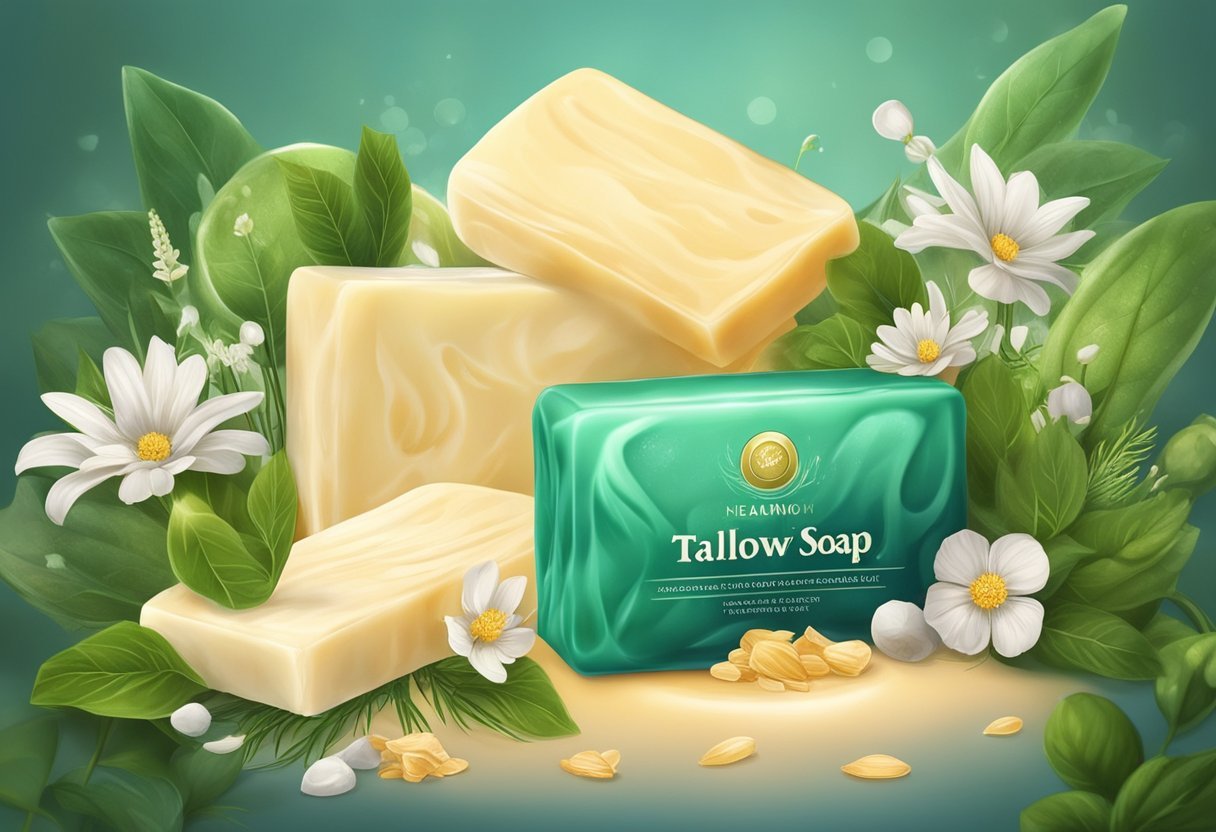
Tallow soap combines the nutrient-rich properties of animal fats with complementary natural ingredients to create products that cleanse without stripping the skin. These ingredients work together to provide optimal skin health benefits while maintaining the skin’s natural moisture barrier.
Role of Natural Oils in Tallow Soap
Natural oils enhance tallow soap’s moisturizing properties while adding their own unique benefits. Shea butter increases the soap’s conditioning qualities and adds extra vitamins to nourish dry skin.
Olive oil provides a gentle cleansing action and contains antioxidants that help protect skin from environmental damage. It creates a mild soap that works well for sensitive skin types.
Coconut oil adds hardness to tallow soap bars while creating a rich, creamy lather. It contains lauric acid, which has antimicrobial properties that can help with skin issues.
Castor oil boosts lather quality and adds a protective layer that locks in moisture. When combined with tallow, these oils create soap that cleanses while supporting the skin’s natural functions.
Comparing Vegetable Oils and Animal Fats
Animal fats like tallow have a fat composition remarkably similar to human skin cells. This similarity allows tallow to be deeply nourishing in ways that vegetable oils cannot match.
Tallow contains fat-soluble vitamins A, D, E, and K that are crucial for skin cell repair and regeneration. Vegetable oils may contain some of these vitamins but often in different forms or concentrations.
The molecular structure of animal fats allows them to penetrate skin layers more effectively than many plant oils. This helps explain why tallow soap users often report improvements for conditions like eczema and psoriasis.
Key Differences Between Animal and Plant Fats:
- Tallow: High in saturated fats, deeply moisturizing, longer shelf life
- Vegetable oils: Varied fatty acid profiles, lighter feeling, different vitamin content
Soap Making Essentials: The Saponification Process

Saponification transforms fats into soap through a precise chemical reaction. This process requires careful measurement and understanding of the ingredients involved to create a successful batch of tallow soap.
Understanding the Chemistry of Soap Making
Saponification is the chemical reaction between fats and an alkali that creates soap. When tallow (animal fat) meets lye (sodium hydroxide), the triglycerides in the fat break down and combine with the lye to form soap molecules and glycerin.
This reaction is not instant. After mixing the melted tallow with lye solution, the mixture needs time to complete the process. The initial thickening, known as “trace,” indicates that saponification has begun. At this point, the mixture resembles pudding consistency.
The complete saponification process takes 24-48 hours during which the soap heats up on its own (called gel phase). During this time, the pH level gradually decreases from highly alkaline to a mild 8-10, making it safe for skin use.
Achieving the Right Balance of Fats and Lye
Calculating the correct ratio of tallow to lye is crucial for creating gentle, effective soap. Too much lye results in harsh, irritating soap, while too little prevents proper saponification.
Recommended Lye Calculator Tools:
- SoapCalc
- Bramble Berry’s Lye Calculator
- Majestic Mountain Sage Calculator
Most soap makers intentionally include a “superfat” percentage of 5-8% when working with tallow. This means adding extra fat beyond what the lye can convert, ensuring no unreacted lye remains in the finished product.
Tallow creates a firm, creamy soap with excellent lathering properties. Its chemical composition closely resembles human skin oils, making it especially compatible with our skin.
The water amount also affects the process—more water slows saponification but gives more working time, while less water speeds up the reaction but requires quicker handling.
The Unique Lather of Tallow Soap
Tallow soap creates a distinctive lather experience that sets it apart from other soap varieties. This natural soap offers a rich, creamy foam that both cleanses effectively and leaves skin feeling nourished.
Qualities of a Creamy Lather
Tallow soap produces a uniquely moisturizing lather that feels luxurious on the skin. Unlike many commercial soaps, tallow-based products create small, dense bubbles rather than large, airy ones. This compact lather stays on the skin longer, allowing the beneficial fatty acids more time to work.
The creamy consistency comes from tallow’s high stearic acid content. This natural fat creates a stable foam that doesn’t quickly dissolve when exposed to water. Many users describe the lather as:
- Silky in texture
- Long-lasting during use
- Dense rather than fluffy
- Smooth against the skin
Tallow lather also tends to be less drying than other soap varieties. The fatty acid profile closely resembles human skin lipids, making it feel natural and comfortable.
Comparing Lather in Tallow vs. Vegetable Soap
Tallow soap lather differs significantly from vegetable-based alternatives. Vegetable soaps often produce quicker, larger bubbles that dissipate more rapidly. Tallow lather builds more slowly but maintains its structure throughout use.
The cleansing power also varies between these soap types:
| Characteristic | Tallow Soap | Vegetable Soap |
|---|---|---|
| Bubble size | Small, dense | Large, airy |
| Build-up time | Slower | Faster |
| Longevity | Extended | Brief |
| Feel on skin | Creamy, moisturizing | Often more stripping |
Tallow soap removes excess oil without stripping natural moisture, creating a balanced cleansing experience. Many users with sensitive skin prefer tallow’s gentle lather for this reason.
The tallow lather also transfers its moisturizing properties more effectively during washing, leaving skin feeling hydrated and supple rather than tight or dry.
Addressing Skin Concerns with Tallow Soap
Tallow soap offers specific benefits for various skin concerns due to its unique composition of natural fatty acids and vitamins. Many people find it helps with both acne management and inflammatory skin conditions.
Tallow Soap for Acne-Prone Skin
Tallow soap can be beneficial for acne-prone skin because it’s naturally non-comedogenic and doesn’t clog pores like some synthetic ingredients might. The sebum-like composition of tallow mimics the skin’s natural oils, which can help balance oil production.
When the skin recognizes similar fatty acids, it may reduce its own sebum production. This balance helps prevent the excess oil that contributes to acne breakouts.
Tallow contains vitamin A, which acts similarly to retinol—a known acne-fighting ingredient. This natural vitamin promotes cell turnover and helps keep pores clear of debris.
Users with acne often report that tallow soap cleanses without stripping the skin of necessary moisture, avoiding the rebound oil production that harsh cleansers can trigger.
Soothing Inflamed Skin Conditions with Tallow
Tallow soap shines when addressing skin inflammation due to its natural anti-inflammatory properties. The stearic acid in tallow helps calm irritated skin, making it suitable for conditions like eczema and psoriasis.
People with sensitive skin often find relief with tallow products because they lack harsh chemicals and detergents found in commercial soaps. The gentle cleansing action removes impurities without aggravating already inflamed skin.
The fat-soluble vitamins (A, D, E, and K) in tallow provide nourishment that helps repair damaged skin barriers—a common issue in inflammatory skin conditions.
Studies have shown that herbal soaps with tallow as a main ingredient demonstrate higher antibacterial efficacy compared to alkaline soaps, helping manage the bacterial component of some skin conditions.
Hydration and Cleansing: A Balancing Act
Tallow soap achieves the perfect balance between cleansing the skin thoroughly and maintaining essential moisture. This rare combination stems from tallow’s unique fatty acid profile that mimics human skin.
The Hydrating Effects of Tallow Soap
Tallow soap contains stearic and oleic acids that provide exceptional hydration. These fatty acids penetrate deeply into the skin, delivering moisture where it’s needed most.
The natural fat content in tallow closely resembles human sebum, making it highly compatible with our skin’s biology. This similarity allows tallow soap to hydrate without causing irritation.
Tallow is packed with vitamins A, D, E, and K, all of which contribute to maintaining skin hydration. Vitamin E, in particular, helps lock in moisture and leaves skin feeling supple.
Many users report that switching to tallow soap eliminates the need for additional moisturizers, especially for normal to dry skin types.
Deep Cleansing without Stripping Natural Oils
Tallow soap effectively removes dirt, makeup, and impurities while preserving the skin’s natural moisture barrier. This makes it superior to many commercial soaps that strip away beneficial oils.
The cleansing action works similarly to the oil cleansing method, where beneficial fats dissolve unwanted oils and impurities without harsh detergents. This gentle approach prevents the tight, dry feeling often experienced after using conventional soaps.
Tallow’s skin-compatible fats create a mild cleansing action that’s effective for:
- Removing daily grime
- Clearing pore blockages
- Dissolving excess sebum
- Maintaining pH balance
For deeper cleansing needs, tallow soap can be combined with ingredients like activated charcoal while still maintaining its hydrating properties.
Crafting Artisanal Soaps with Traditional Ingredients
Traditional soapmaking embraces time-tested ingredients that deliver superior cleansing and moisturizing benefits. The art of crafting tallow-based soaps connects modern artisans with historical practices while producing products that work harmoniously with the skin.
The Homesteading Approach to Soap Making
Homesteading soap makers focus on self-sufficiency and using materials readily available on their land. The process begins with carefully rendering fat, typically from their own livestock or locally sourced animals.
Quality rendered fat creates the foundation for excellent tallow soap. The rendering process involves:
- Cleaning the fat thoroughly to remove impurities
- Slow-melting over low heat
- Straining to achieve pure tallow
Many homesteaders use the cold-process method, which preserves the natural glycerin that closely mimics human skin lipids. This connection to traditional craftsmanship results in handmade soaps with excellent skin compatibility.
Small-batch production allows for careful quality control and customization. Homesteaders often incorporate herbs, flowers, and essential oils from their gardens, creating truly sustainable products.
Blending Tallow with Other Traditional Fats
Artisanal soapmakers enhance tallow’s properties by combining it with complementary traditional fats. These combinations create balanced bars with improved characteristics.
Popular Traditional Fat Combinations:
| Fat Type | Contribution to Soap |
|---|---|
| Coconut Oil | Creates abundant lather |
| Olive Oil | Adds gentle moisturizing |
| Shea Butter | Provides deep hydration |
| Lard | Increases hardness and longevity |
Blending fats requires understanding their saponification values—the amount of lye needed to convert each fat into soap. This technical knowledge ensures properly balanced, safe products.
The ratio of tallow to other fats significantly impacts the final soap. Higher tallow percentages create firmer bars with deep hydration properties. These balanced formulations produce soaps that cleanse effectively without stripping skin of natural oils.
Identifying and Incorporating Quality Fats and Oils
The foundation of exceptional tallow soap lies in selecting premium ingredients and understanding how different fats interact. Proper combinations enhance both cleansing and moisturizing properties.
Selecting High-Quality Fats for Premium Soap
When selecting fats for soap making, the quality of your tallow matters significantly. Look for beef tallow from grass-fed cattle, as it contains higher levels of vitamins A, D, E, and K compared to conventionally raised animals.
Properly rendered tallow should be creamy white with minimal odor. This indicates thorough processing that removes impurities while preserving beneficial properties.
Other animal fats like lard (pork fat) can serve as alternatives, offering similar benefits but with a slightly different fatty acid profile. Lard produces a milder soap with abundant lather.
For soap makers, the hardness of the finished bar is crucial. Tallow and lard create firm bars that resist dissolving quickly when wet, extending the soap’s usable life.
Benefits of Blending Tallow with Plant-Based Oils
Combining tallow with plant oils creates a balanced soap that maximizes beneficial properties. Each oil contributes unique characteristics to the final product.
Popular Tallow-Oil Combinations:
- Tallow + Coconut Oil: Enhances lather and cleansing power
- Tallow + Olive Oil: Adds extra moisturizing properties
- Tallow + Castor Oil: Improves lather stability and creaminess
Coconut oil works exceptionally well with tallow, as it produces abundant bubbles while tallow provides moisturizing properties and bar hardness.
For sensitive skin, lower the coconut oil percentage (10-15%) and increase tallow (50-60%) to reduce potential dryness while maintaining cleansing effectiveness.
Plant oils add specific benefits: avocado oil contributes vitamins, shea butter adds luxury, and jojoba closely resembles human sebum. This customization allows soap makers to address different skin needs.
Exploring Additional Natural Additives in Tallow Soap
Tallow soap provides an excellent base for incorporating various natural ingredients that enhance its cleansing and therapeutic properties. These additives can transform basic tallow soap into specialized products that address specific skin concerns.
Using Essential Oils for Fragrance and Therapy
Essential oils are concentrated plant extracts that add both natural fragrance and therapeutic benefits to tallow soap. Lavender oil offers calming properties for irritated skin, while tea tree oil provides powerful antimicrobial effects. Peppermint creates an invigorating sensation, and citrus oils like lemon and orange deliver uplifting scents.
The method of adding these oils matters. They should be incorporated during the “trace” phase of soap making when the mixture has slightly thickened but before it hardens. Most recipes recommend using about 30-50 drops of essential oil per pound of soap base.
Different oils serve different purposes:
- Relaxation: Lavender, chamomile, ylang-ylang
- Energizing: Peppermint, rosemary, eucalyptus
- Skin healing: Frankincense, geranium, helichrysum
Antibacterial and Healing Additives
Beyond essential oils, tallow soap makers incorporate various natural ingredients with antibacterial and healing properties. Activated charcoal detoxifies by drawing impurities from the skin, making it ideal for acne-prone complexions. Clay minerals like bentonite and kaolin absorb excess oil while delivering beneficial minerals.
Botanical additives offer unique benefits too. Calendula petals provide gentle anti-inflammatory properties that soothe irritated skin. Oatmeal acts as a mild exfoliant while calming sensitive skin conditions like eczema.
Honey deserves special attention as a multifunctional additive. It’s naturally antibacterial, deeply moisturizing, and helps repair damaged skin. When combined with tallow’s nourishing properties, these ingredients create soaps that clean effectively while supporting the skin’s natural healing processes.
Customizing Tallow Soap for Different Skin Types
Tallow soap can be easily tailored to address specific skin concerns through thoughtful ingredient selection and formulation adjustments. The natural fat base provides an excellent foundation that can be enhanced for various skin needs.
Formulas for Sensitive Skin
People with sensitive skin benefit from simple, unscented tallow soap formulations that minimize potential irritants. Tallow soap is gentle and nourishing for all skin types, including sensitive skin.
For maximum gentleness, consider these modifications:
- Unscented base: Avoid essential oils and fragrances that might trigger reactions
- Higher superfat percentage (8-10%): Creates a milder, less alkaline soap
- Added soothing ingredients: Colloidal oatmeal, calendula, or chamomile
Sweet almond oil (2-5% of recipe) brings anti-inflammatory properties and vitamin E to sensitive formulations without heaviness. This addition helps maintain the skin barrier while cleansing.
For extremely reactive skin, simplify further by using only pure tallow with minimal additives and a longer cure time (6-8 weeks) to ensure gentleness.
Enriching Soaps with Specific Skin Benefits
Different carrier oils can transform basic tallow soap into specialized treatments for various skin conditions. The goal is maintaining tallow’s natural benefits while enhancing its suitability for different skin types.
For dry skin:
- Avocado oil (5-7%): Deep moisturization and vitamin E
- Shea butter (up to 10%): Locks in moisture
- Honey (1 tablespoon per pound): Natural humectant
For oily or acne-prone skin:
- Sunflower oil (3-5%): Lightweight, non-comedogenic
- Tea tree essential oil (0.5%): Antimicrobial properties
- Clay additives (1 tablespoon per pound): Helps absorb excess oil
Tallow soap rich in fat-soluble vitamins A, D, E, and K provides a solid foundation. These vitamins promote skin repair and provide a natural glow when paired with complementary ingredients that address specific concerns.
Have questions or curious to learn more? We’d love to hear from you—reach out anytime through our contact page!
RELATED POSTS
View all


